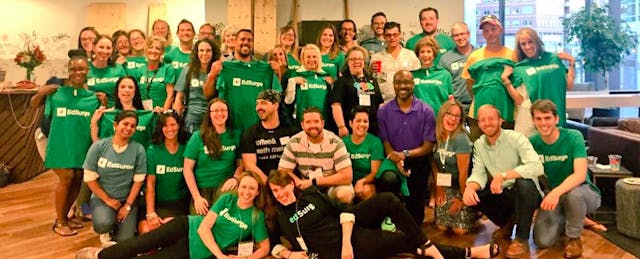Who can be a “collaborative changemaker”? Anyone, according to St. Louis Technology Integration Coach Patricia Brown.
Speaking on panel at the PBS Digital Innovators event, Brown talked up the rise of the online spaces for collaboration, also known as personal learning networks (PLN) as enabling anyone, even those who in remote areas or who feel more introverted, to come together to collaborate and share ideas. These networks, often found on Facebook or Twitter, are spaces where educators around the world can meet each other to share ideas and best practices. They are often organized around subjects or grades.
The rise of the PLN as a common tool was increasingly evident at the ISTE conference, where people could be spotted looking awkwardly at each other, seemingly thinking, “Is that my Twitter friend who has a clearly outdated profile picture?” If they realized that it was, in fact, their online friend, many immediately would embrace, as if they were running into a college roommate they hadn’t seen in years.
Recently, EdSurge had the opportunity to dive into PLNs as we ran an early beta pilot of the EdSurge K12 Educators Group. It’s an an educator-only community which allows educators to have conversations around technology integration in schools (not tied to any specific program). It’s a space dedicated not to specific products but rather to larger issues such as implementing blended learning, helping your colleagues find the “why” of their technology integrations or a searching for that one tool that fits a school’s learning objectives just right.
On June 27 at ISTE, we invited all of beta-tester educators to meet in person as we opened the group to the public. The educators had spent the last three months building relationships online, and the meetup was the first time they had connected in person. Here’s what we learned about bringing the 2D virtual PLN into a 3D world:
Inspiration happens when you feel like you can relate to someone:
Many educators have been curating their online personas and networks for many years. Some educators, by contrast, are new to the online PLN, and that can feel as if some educators are more experienced or their ideas and voices are louder. Meeting in person humanizes the online space. Good ideas and inspiration are more likely to spread when you feel like the person making the change is someone you can relate to and someone you feel confident reaching out to with questions that begin with “This may be a stupid question, but...” Meeting in real life enables your group to feel as though they can better relate to one another, which can increase the spread of great ideas and practices.
The space you create matters:
Meeting in person is not possible for everyone, but consider thinking about the human elements when you design and engage in your online PLN. An event requires everyone to be actively contributing and listening, and an online group needs to have a similar flow. In person there is also a certain amount of playfulness and humor that online interactions sometimes lack. Collaboration is not about snappy one liners in a Twitter chat, it’s about getting to know someone sharing ideas and having some fun along the way.
We at EdSurge hope this is the first of many online to offline events we get to share with the amazing educators who are part of our community. The online is what creates follow through and enables you to get feedback in the moment you need it, but it is the offline that gets us out of our heads and our personas and makes the work we do feel real.


